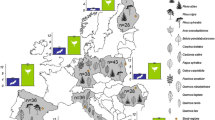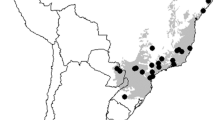Abstract
Space and environment are fundamental in influencing the community structure. However, their relative influences vary according to species’ biological characteristics. Here we test whether differences in life-history traits mainly linked to dispersal abilities influence bat, rodent and marsupial beta diversity along spatial and environmental gradients. We expect bat beta diversity to be weakly related with space in comparison to dispersal-limited rodents and marsupials. Using data from communities distributed along the Atlantic Forest of South America, we calculated the total beta diversity and its turnover and nestedness components for each group. We estimated the strength of correlation of beta diversity and its components along spatial and environmental gradients, comparing their importance within and between groups. Space had the higher influence on rodent and marsupial beta diversity. For bats, both gradients influenced similarly their community composition. Between taxa, the influence of these gradients did not differ for rodents and marsupials, while bats presented a stronger relationship with environment compared to non-volant small mammals. Also, all groups presented a similar influence of the spatial gradients on their community structure, despite their differences in dispersal abilities. Our results suggest that differences in biological characteristics partially influence the community structure of these mammals, with their responses along space likely reflecting similar biogeographical dynamics affecting their distribution. Overall, our results improve the understanding of the processes structuring these communities, highlighting the benefits of comparative analyses within a beta diversity perspective to better understand the influence of multiple processes on the community assembly along geographical gradients.




Similar content being viewed by others
References
Anderson MJ, Crist TO, Chase JM, Vellend M, Inouye B, Freestone AL, Sanders N, Cornell HV, Comita LS, Davies KF, Harrison SP, Kraft NJB, Stegen JC, Swenson NG (2011) Navigating the multiple meanings of beta diversity: a roadmap for the practicing ecologist. Ecol Lett 14:19–28. https://doi.org/10.1111/j.1461-0248.2010.01552.x
Arita HT, Rodríguez P (2004) Local-regional relationships and the geographical distribution of species. Glob Ecol Biogeogr 13:15–21. https://doi.org/10.1111/j.1466-882X.2004.00067.x
Baselga A (2010) Partitioning the turnover and nestedness components of beta diversity. Glob Ecol Biogeogr 19:134–143. https://doi.org/10.1111/j.1466-8238.2009.00490.x
Baselga A (2012) The relationship between species replacement, dissimilarity derived from nestedness, and nestedness. Glob Ecol Biogeogr 21:1223–1232. https://doi.org/10.1111/j.1466-8238.2011.00756.x
Baselga A, Leprieur F (2015) Comparing methods to separate components of beta diversity. Methods Ecol Evol 6:1069–1079. https://doi.org/10.1111/2041-210X.12388
Baselga A, Orme CDL (2012) Betapart: an R package for the study of beta diversity. Methods Ecol Evol 3:808–812. https://doi.org/10.1111/j.2041-210X.2012.00224.x
Baselga A, Gómez-Rodríguez C, Lobo JM (2012) Historical legacies in world amphibian diversity revealed by the turnover and nestedness components of beta diversity. PLoS One. https://doi.org/10.1371/journal.pone.0032341
Bovendorp RS, Villar N, de Abreu-Junior EF, Bello C, Regolin AL, Percequillo AR, Galetti M (2017) Atlantic small-mammal: a dataset of communities of rodents and marsupials of the Atlantic Forests of South America. Ecology. https://doi.org/10.1002/ecy.1893
Buckley LB, Jetz W (2008) Linking global turnover of species and environments. Proc Natl Acad Sci USA 105:17836–17841. https://doi.org/10.1073/pnas.0803524105
Costa LP, Leite YLR (2012) Historical fragmentation shaping vertebrate diversification in the Atlantic Forest biodiversity hotspot. In: Patterson B, Costa LP (eds) Bones, clones and biomes: the history and geography of recent Neotropical mammals. The University of Chicago Press, Chicago, pp 283–306
Costa LP, Leite YLR, Fonseca GA, Fonseca MT (2000) Biogeography of South American Forest mammals: endemism and diversity in the Atlantic Forest. Biotropica 32:872–881. https://doi.org/10.1111/j.1744-7429.2000.tb00625.x
Cottenie K (2005) Integrating environmental and spatial processes in ecological community dynamics. Ecol Lett 8:1175–1182. https://doi.org/10.1111/j.1461-0248.2005.00820.x
Currie DJ (1991) Energy and large-scale patterns of animal- and plant-species richness. Am Nat 137:27–49
Dambros CS, Cáceres NC, Magnus L, Gotelli NJ (2015) Effects of neutrality, geometric constraints, climate, and habitat quality on species richness and composition of Atlantic Forest small-mammals. Glob Ecol Biogeogr 24:1084–1093. https://doi.org/10.1111/geb.12330
De Bie T, De Meester L, Brendonck L, Martens K, Goddwweis B, Ercken D, Hampel H, Denys L, Vanhecke L, Van der Gucht K, Van Wichelen J, Vyverman V, Declerck S (2012) Body size and dispersal mode as key traits determining metacommunity structure of aquatic organisms. Ecol Lett 15:740–747. https://doi.org/10.1111/j.1461-0248.2012.01794.x
de la Sancha NU, Higgins CL, Presley SJ, Strauss RE (2014) Metacommunity structure in a highly fragmented forest: has deforestation in the Atlantic Forest altered historic biogeographic patterns? Divers Distrib 20:1058–1070. https://doi.org/10.1111/ddi.12210
Dobrovolski R, Melo AS, Cassemiro FAS, Diniz-Filho JAF (2012) Climatic history and dispersal ability explain the relative importance of turnover and nestedness components of beta diversity. Glob Ecol Biogeogr 21:191–197. https://doi.org/10.1111/j.1466-8238.2011.00671.x
Esbérard CEL, Godoy MSM, Renovato L, Carvalho WD (2017) Novel long-distance movements by Neotropical bats (Mammalia: Chiroptera: Phyllostomidae) evidenced by recaptures in Southeastern Brazil. Stud Neotropical Fauna Environ 52:75–80. https://doi.org/10.1080/01650521.2016.1273751
Field R, Hawkins BA, Cornell HV, Currie DJ, Diniz-Filho JAF, Guégan JF, Kaufman DM, Kerr J, Mittelbach GG, Oberdorff T, O´Brien EM, Turner JRG (2009) Spatial species-richness gradients across scales: a meta-analysis. J Biogeogr 36:132–147. https://doi.org/10.1111/j.1365-2699.2008.01963.x
Galetti M, Rodarte RR, Neves CL, Moreira M, Costa-Pereira R (2016) Trophic niche differentiation in rodents and marsupials revealed by stable isotopes. PLoS One 11:e0152494. https://doi.org/10.1371/journal.pone.0152494
Gómez-Rodríguez C, Baselga A (2018) Variation among European beetle taxa in patterns of distance decay of similarity suggests a major role of dispersal processes. Ecography. https://doi.org/10.1111/ecog.03693
Goslee SC, Urban DL (2007) The ecodist package for dissimilarity-based analysis of ecological data. J Stat Softw 22:1–19. https://doi.org/10.18637/jss.v022.i07
Graham CH, Storch D, Machac A (2018) Phylogenetic scale in ecology and evolution. Glob Ecol Biogeogr 27:175–187. https://doi.org/10.1111/geb.12686
Hijmans RJ, Cameron SE, Parra JL, Jones PG, Jarvis A (2005) Very high resolution interpolated climate surfaces for global land areas. Int J Climatol 25:1965–1978. https://doi.org/10.1002/joc.1276
Hill MJ, Heino J, Thornhill I, Ryves DB, Wood PJ (2017) Effects of dispersal mode on the environmental and spatial correlates of nestedness and species turnover in pond communities. Oikos 126:1575–1585. https://doi.org/10.1111/oik.04266
Legendre P (2014) Interpreting the replacement and richness difference components of beta diversity. Glob Ecol Biogeogr 23:1324–1334. https://doi.org/10.1111/geb.12207
Legendre P, Legendre L (2012) Numerical ecology, 3rd edn. Elsevier, New York
López-González C, Presley SJ, Lozano A, Stevens RD, Higgins CL (2015) Ecological biogeography of Mexican bats: the relative contributions of habitat heterogeneity, beta diversity, and environmental gradients to species richness and composition patterns. Ecography 38:261–272. https://doi.org/10.1111/ecog.00813
Lyons SK, Willig MR (1997) Latitudinal patterns of range size: methodological concerns and empirical evaluations for New World bats and marsupials. Oikos 79:568–580. https://doi.org/10.2307/3546901
Maestri R, Patterson BD (2016) Patterns of species richness and turnover for the South American rodent fauna. PLoS One 11:e0151895. https://doi.org/10.1371/journal.pone.0151895
Muylaert RL, Stevens RD, Esbérard CEL, Mello MAR, Garbino GST, Varzinczak LH, Faria D, Weber MM, Rogeri PK, Regolin AL, Oliveira HFM, Costa LDM, Barros MAS, Sabino-Santos G Jr, Morais MAC, Kavagutti VS, Passos FC, Marjakangas EL, Maia FGM, Ribeiro MC, Galetti M (2017) Atlantic bats: a data set of bat communities from the Atlantic Forests of South America. Ecology 98:3227. https://doi.org/10.1002/ecy.2007
Myers N, Mittermeier RA, Mittermeier CG, Fonseca GAB, Kent J (2000) Biodiversity hotspots for conservation priorities. Nature 403:853–858. https://doi.org/10.1038/35002501
Nekola JC, White PS (1999) The distance decay of similarity in biogeography and ecology. J Biogeogr 26:867–878. https://doi.org/10.1046/j.1365-2699.1999.00305.x
Norberg UM, Rayner JMV (1987) Ecological morphology and flight in bats (Mammalia; Chiroptera): wing adaptations, flight performance, foraging strategy and echolocation. Philos Trans R Soc B Biol Sci 316:335–427. https://doi.org/10.1098/rstb.1987.0030
Oksanen J, Blanchet FG, Friendly M, Kindt R, Legendre P, McGlinn D, Michin PR, O’Hara RB, Simpson GL, Solymos P, Stevens MHM, Szoecs E, Wagner H (2017) Vegan: Community ecology package. R package version 2.4-4. http://CRAN.Rproject.org/package=vegan. Accessed 20 Feb 2017
Oliveira-Filho AT, Fontes AL (2000) Patterns of floristic differentiation among Atlantic Forests in Southeastern Brazil and the influence of climate. Biotropica 32:793–810. https://doi.org/10.1111/j.1744-7429.2000.tb00619.x
Qian H (2009) Beta diversity in relation to dispersal ability for vascular plants in North America. Glob Ecol Biogeogr 18:327–332. https://doi.org/10.1111/j.1466-8238.2009.00450.x
Qian H, Ricklefs RE (2012) Disentangling the effects of geographic distance and environmental dissimilarity on global patterns of species turnover. Glob Ecol Biogeogr 21:341–351. https://doi.org/10.1111/j.1466-8238.2011.00672.x
R Core Team (2016) R: a language and environment for statistical computing. R foundation for statistical computing, Vienna, Austria. https://www.R-project.org/. Accessed 30 Nov 2016
Ribeiro MC, Metzger JP, Martensen AC, Ponzoni FJ, Hirota MM (2009) The Brazilian Atlantic Forest: how much is left, and how is the remaining forest distributed? Implications for conservation. Biol Conserv 142:1141–1153. https://doi.org/10.1016/j.biocon.2009.02.021
Simard M, Pinto N, Fisher JB, Baccini A (2011) Mapping forest canopy height globally with spaceborne lidar. J Geophys Res Biogeosciences 116:1–12. https://doi.org/10.1029/2011JG001708
Soininen J, McDonald R, Hillebrand H (2007) The distance decay of similarity in ecological communities. Ecography 30:3–12. https://doi.org/10.1111/j.2006.0906-7590.04817.x
Soininen J, Heino J, Wang J (2017) A meta-analysis of nestedness and turnover components of beta diversity across organisms and ecosystems. Glob Ecol Biogeogr 27:96–109. https://doi.org/10.1111/geb.12660
Stein A, Gerstner K, Kreft H (2014) Environmental heterogeneity as a universal driver of species richness across taxa, biomes and spatial scales. Ecol Lett 17:866–880. https://doi.org/10.1111/ele.12277
Stevens RD (2004) Untangling latitudinal richness gradients at higher taxonomic levels: familial perspectives on the diversity of New World bat communities. J Biogeogr 31:665–674. https://doi.org/10.1111/j.1365-2699.2003.01042.x
Stevens RD (2013) Gradients of bat diversity in Atlantic Forest of South America: environmental seasonality, sampling effort and spatial autocorrelation. Biotropica 45:764–770. https://doi.org/10.1111/btp.12056
Stevens RD, Tello JS (2012) Do desert rodents form metacommunities? J Mamm 93:1029–1041. https://doi.org/10.1644/11-MAMM-A-292.2
Stevens RD, López-González CL, Presley SJ (2007) Geographical ecology of Paraguayan bats: spatial integration and metacommunity structure of interacting assemblages. J Anim Ecol 76:1086–1093. https://doi.org/10.1111/j.1365-2656.2007.01288.x
Trabucco A, Zomer RJ (2009) Global aridity index (global-aridity) and global potential evapo-transpiration (Global-PET) geospatial database. http://www.csi.cgiar.org Accessed 15 Dec 2016
Trabucco A, Zomer RJ (2010) Global soil water balance geospatial database.http://www.cgiar-csi.org Accessed 15 Dec 2016
Tuomisto H, Ruokolainen K, Yli-Halla M (2003) Dispersal, environment, and floristic variation of Western Amazonian forests. Science 299:241–244. https://doi.org/10.1126/science.1078037
USGS (2003) Global 30-arc-second elevation data set (GTOPO30). http://lta.cr.usgs.gov/GTOPO30 Accessed 25 Nov 2015
Varzinczak LH, Lima CS, Moura O, Passos FC (2018) Relative influence of spatial over environmental and historical processes on the taxonomic and phylogenetic beta diversity of Neotropical phyllostomid bat assemblages. J Biogeogr 45:617–627. https://doi.org/10.1111/jbi.13150
Vavrek M (2015) Fossil: palaeoecological and palaeogeographical analysis tools. R package version 0.3.7
Whittaker RH (1960) Vegetation of the Siskiyou Mountains, Oregon and California. Ecol Monogr 30:279–338
Acknowledgements
We thank Sidney F. Gouveia for suggestions on an early version of this manuscript. We extend our most sincere acknowledgements to all researchers that collected data on these mammal assemblages in the field, and to all researchers that jointed efforts to make these data available as part of the “Atlantic-datasets: beyond distribution maps” project.
Funding
LHV and CSL received scholarships from the Brazilian Coordination for the Improvement of Higher Education Personnel (CAPES). MOM (309154/2014-6) and FCP (307303/2017-9) received support from the Brazilian National Council for Scientific and Technological Development (CNPq).
Author information
Authors and Affiliations
Contributions
LHV, MOM and FCP conceived the ideas. LHV and CSL collected the data. LHV performed statistical analysis. LHV led the writing with substantial contribution from all authors.
Corresponding author
Ethics declarations
Conflict of interest
The authors declare that they have no conflict of interest.
Ethical approval
This article does not contain any studies with human participants or animals performed by any of the authors. For this type of study formal consent is not required.
Additional information
Communicated by Mathew Samuel Crowther.
Testing hypotheses with community data in a macroecological context and based on solid theory is essential to understand the factors underlying the community structure along geographical gradients.
Electronic supplementary material
Below is the link to the electronic supplementary material.
Rights and permissions
About this article
Cite this article
Varzinczak, L.H., Moura, M.O., Lima, C.S. et al. How do bat, rodent, and marsupial communities respond to spatial and environmental gradients? Insights from a deconstruction of mammal beta diversity from the Atlantic Forest of South America. Oecologia 189, 851–861 (2019). https://doi.org/10.1007/s00442-018-4288-y
Received:
Accepted:
Published:
Issue Date:
DOI: https://doi.org/10.1007/s00442-018-4288-y




